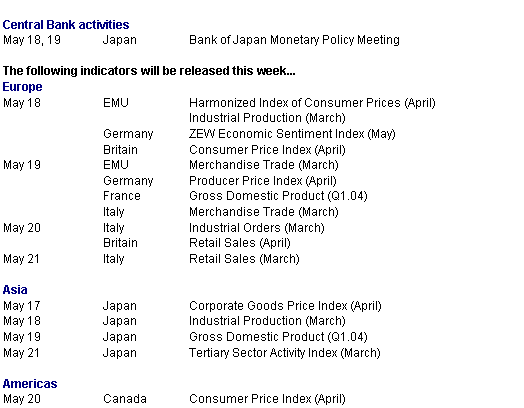Monday, May 17, 2004

Growth prospects from OECD
First the "good" news. The Organization for Economic Cooperation and Development (OECD) lifted its forecasts for global economic growth in 2004 and 2005 but said the recovery is threatened by lagging eurozone performance, the risk of a sharp increase in interest rates and an oil price shock. OECD expects growth across its 30 industrialized member countries to average 3.4 percent in 2004 and 3.3 percent in 2005. Developing countries such as China, India and Brazil are not members of this club. OECD expects the U.S. economy to jump 4.7 percent this year and 3.7 percent next year. Business spending is expected to help Japan grow 3 percent this year though growth could slow to 2.8 percent next year. In contrast with the forecasts for the United States and Japan, which were raised from their November 2003 estimates, OECD lowered its growth forecast for the euro region for both 2004 and 2005 to 1.6 percent and 2.4 percent, respectively. The OECD, founded in 1961 from the organization that administered aid through the Marshall Plan after World War II, promotes dialogue among members in an effort to coordinate domestic and international policies.
Oil price increases prey on investors
Saudi Arabia has reversed its February position when they persuaded the Organization of the Petroleum Exporting Countries (OPEC) to cut its total production quota by one million barrels per day (bpd) as a precaution against an anticipated oil price crash when demand fell at the end of the northern hemisphere heating season. Now they fear the opposite - that prices will soar. The price of West Texas crude is over $41 a barrel, its highest price since the eve of the first Iraq war. The soaring price is prompting fears that higher oil prices could sap the vigor of the U.S. economy and compound the frailty of Europe's already anemic recovery.
Part of the reason for rising oil prices has been the strengthening world economy. China's burgeoning economy is using about 15 percent more oil than a year ago. Demand is also strong in the rest of Asia. As the year progresses and U.S. drivers take to the road for summer vacations, demand will rise, especially for the lighter, sweeter crudes that are needed for gasoline. Supply factors are also worrying investors as evidenced by the recent sabotage of Iraqi and Saudi Arabian oil facilities.

Until recently, the rise in the dollar price of oil was offset outside the United States and China by the drop in the value of the dollar (oil is priced in U.S. dollars and the Chinese currency is pegged to the dollar.) But even though the currency has regained some ground in recent weeks, oil prices have continued to climb.
Global Markets
Equities were very jittery all last week. The week started off badly with all 13 of the indexes followed here being battered by big sell offs. Four factors were cited for the declines - the situation in Iraq is going from bad to worse; the incumbent presidential candidate is being perceived as vulnerable; a backlash is possible against U.S. companies overseas because of the prisoner-abuse scandal; and climbing oil prices.
Stocks were hammered in Asia as investors feared the strengthening U.S. economy may attract investment out of Asia and that China may further attempt to cool its red hot economy. Stocks in Europe and Britain also plummeted. Whatever may be causing the global jitters, strong economic data from the U.S. haven't been a calming factor. The stronger-than-expected U.S. employment situation report was viewed as the latest in a string of positive reports that could nudge the Fed to raise interest rates and further upset equity investors.

Global Stock Market Recap

Europe and Britain
In an up one day and down the next week, the CAC and DAX were down for a third week. Investors failed to be enthused by flash GDP data that showed France, Germany and Italy growing at a faster-than-expected rate in the first quarter but still significantly slower than the U.S. and Japan (see indicator scoreboard below). The FTSE, which had risen the previous week, was also down on the week. Airline stocks were hurt by the prospect of higher oil prices eating into potential profits. Already many airlines including British Airways have instituted fuel surcharges. The specter of higher interest rates in the U.S. continues to cast a deep shadow over global equity markets. And set against a backdrop of geopolitical tension and oil prices approaching all-time highs, investors are bound to fret.

Asia/Pacific
Asian stocks sank last week on concern rising oil prices may slow economic growth, hurting export demand for products such as cameras, cars and computers. The logic is that higher oil prices will eventually lead to higher costs for companies which, in turn, will put pressure on earnings if price increases cannot be passed along to consumers. Stocks were volatile as they alternated between gains and losses as some investors debated whether higher borrowing costs in the U.S. combined with energy costs would slow growth. The Nikkei had its biggest gain in 21 months on Wednesday after plummeting on Monday by the most since the day after the September 11th terrorist attacks.
Japan imports virtually all of its crude supplies and wants stable supplies along with favorable crude oil prices. Except for Japan, South Korea will be the hardest hit among Asian economies in the event that global oil prices keep surging as its factories rely on imported oil. But the stock market's biggest concern is a possible slowdown in economic growth in the U.S. from soaring oil prices.

Currencies
The dollar was up once again against most currencies, although some of the gains were eroded on Friday after the CPI came in as forecast. The foreign exchange markets have been focusing on a Fed interest rate increase. The dollar rose on Thursday, for example, when the producer price index rose at the fastest pace since March 2003 and bolstered expectations for a Federal Reserve interest rate increase.
With inflation showing signs of life, market players have begun to fear a replay of 1994, when the Federal Reserve began raising U.S. interest rates by 25 basis points in February to 3.25 percent and then continued to tighten, at times in 50 to 75 basis point increments, until the cycle ended in February 1995 with rates at 6.0 percent.

The yen has been particularly buffeted by the sell off in equities in Japan. The yen dropped to an eight-month low after Japanese stocks tumbled. Since mid-February the dollar has climbed against all but one major currency, including a 7 percent rebound from a record low of $1.2930 against the euro amid evidence of a strengthening U.S. economy. A better-than-forecast jobs report prompted many traders and economists to say the Fed would raise its target lending rate in June, sooner than previously predicted.
Indicator scoreboard
EMU - First quarter flash gross domestic product was up 0.6 percent and 1.3 percent when compared with the same quarter last year. The flash estimate contains no information on GDP components. The estimate of GDP growth is derived from seasonally adjusted data and is calculated by using available numbers from Germany, France, Italy, the Netherlands and Finland as well as related indicators from Spain, for which first quarter data are not yet available.

Germany - March seasonally adjusted merchandise trade surplus was �13.9 billion, up from February's surplus of �12.0 billion. Unadjusted exports were up 16.6 percent while imports were up 5.3 percent on the year.

April wholesales price index was up 0.4 percent and 2.4 percent when compared with last year. Prices for metals and grains were up sharply. The WPI data series now has a base year of 2000=100.
First quarter flash seasonally and calendar adjusted gross domestic product was up 0.4 percent and 0.7 percent when compared with the first quarter of last year. The flash report does not provide data for GDP components. However, the Statistics Office said that the quarterly increase was due solely to stronger net exports. Domestic demand was down on the quarter.

France - March seasonally adjusted industrial output inched up 0.1 percent and was up 1.2 percent when compared with last year. Manufacturing output declined 0.3 percent but managed to climb 0.2 percent on the year thanks to declines in output of both capital goods (concentrated mainly in aerospace) and semi-finished goods.

Flash first quarter gross domestic product was up 0.8 and 1.7 percent when compared with last year. INSEE, the French statistical agency, noted the improvement in growth was due to an increase in household consumption. Details on components are not available in flash releases but will be available on May 19 when the preliminary GDP estimate is released.

March seasonally adjusted merchandise trade surplus jumped to �827 million from �320 million in the previous month. Exports were up 4.5 percent after sinking 3.7 percent in February. Export growth was especially strong with other eurozone countries and especially Germany. Imports were up 2.7 percent after declining 1.5 percent in February.

Italy - First quarter real, seasonally and workday adjusted gross domestic product was up 0.4 percent and 0.8 percent when compared with the same quarter a year ago. ISTAT, the Italian statistical agency, provided no data for components. However, it did say that value added from service and agriculture were both up while industry was down.

March seasonally and workday adjusted industrial output excluding construction was down 0.4 percent and down 0.4 percent when compared with last year. Output of consumer goods, intermediate goods and energy goods was down on the month. Investment goods output was flat. However machinery and mechanical equipment output was up.

Britain - April producer output prices were up 0.3 percent and 1.8 percent when compared with last year. Core output prices were flat on the month and up 1.5 percent on the year. The increase was partly due to higher alcohol, tobacco and petroleum prices. Producer input prices were up 0.8 percent and jumped 3.4 percent on the year. Higher input prices reflected higher prices for crude oil and other imported parts and equipment prices. Crude oil prices were up 0.8 percent and 13.4 percent on the year.

March industrial output was flat and was down 0.6 percent when compared with last year. Manufacturing output was down 0.3 percent but managed to increase 0.4 percent on the year. Eight of 13 sectors registered declines.
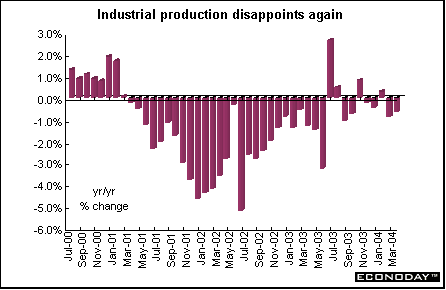
April claimant count unemployment declined by 6,000. However, the claimant count unemployment rate remained at 2.9 percent. International Labour Organization unemployment for the three months of January through March was down 48,000 from the previous three months. The ILO unemployment rate was 4.8 percent, down from the previous month's 4.9 percent rate.

Average earnings for the three months to March was up 5.2 percent when compared with the same three months a year ago. Average earnings now exceed the Bank of England's target of 4.5 percent. Excluding bonuses, average earnings rose 3.9 percent. Average earnings in the private sector were up 5.5 percent while service sector earnings were up 5.7 percent.
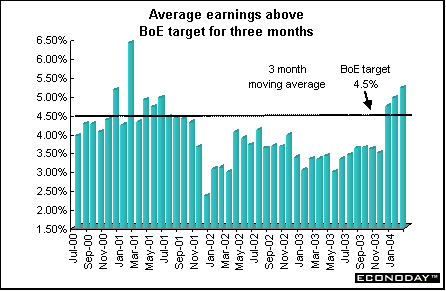
March global merchandise trade deficit narrowed to Stg4.051 billion from Stg4.053 billion in February. Exports were up 1.7 percent while imports climbed 1.3 percent. The non-EU deficit was Stg2.016 billion, about the same as in February. Non-EU exports were up 3.5 percent while non-EU imports were up 2.7 percent.

Asia
Australia - April unemployment rate remained at a 14-year-low of 5.6 percent. Employment was up by 56,200 jobs. The Australian Bureau of Statistics applied a special seasonal adjustment because it began the April monthly survey of the labor market on the Easter Monday holiday, which may have distorted the figures. The last time it applied a special seasonal adjustment for Easter was in 1996. Full time employment was up 43,400 and part time jobs increased 12,800.
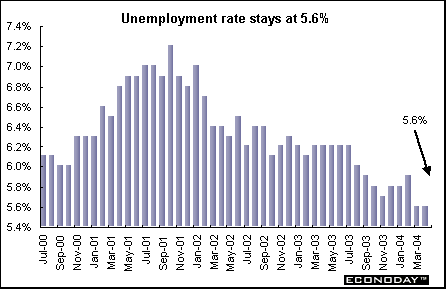
Americas
Canada - March merchandise trade surplus jumped to C$6.2 billion from C$5.9 billion in the previous month. Exports jumped 1.7 percent while imports were up 0.9 percent. Exports increased to all trading areas with the exception of Japan. The Canadian surplus with the U.S. was virtually unchanged on the month at C$8.1 billion. Exports to the U.S. were up 0.9 percent while imports remained virtually unchanged from the prior month.
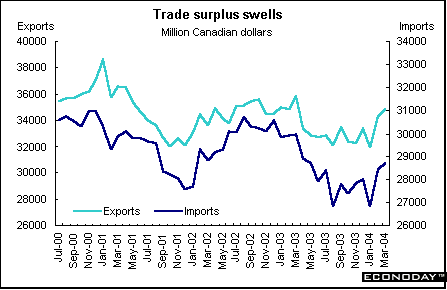
March factory shipments soared 3.4 percent and were up 1.7 percent when compared with last year. Nineteen of 21 manufacturing industries, accounting for 98 percent of total shipments, were up. Motor vehicle shipments soared by 8.2 percent as improved incentive packages, coupled with the manufacturing of new product lines and strong demand for various models, contributed to the third boost in motor vehicle production in the last four months. Shipments for primary metals, fabricated metal products and wood products were also up sharply. Unfilled orders increased 0.2 percent for the third monthly rise in a row, the longest string of increases since 1999. New orders jumped 2.4 percent to the highest level since November 2000.
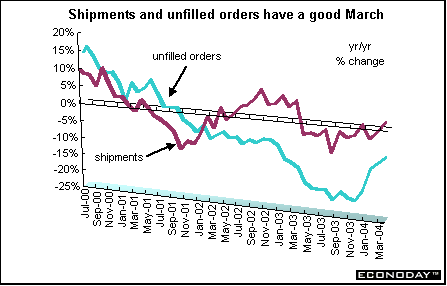
Bottom line
Well, the flash GDP numbers in Europe are here and Germany, France, Italy and the EMU grew at a faster-than-expected rate in the first quarter of 2004. Both the Italian and German economies expanded 0.4 percent from the previous quarter while France expanded by 0.8 percent. EMU grew at 0.6 percent in the first quarter. This eased pressure on the European Central Bank to lower interest rates. Analysts think there is little chance of a rate cut now. The ECB, which has rejected calls from political leaders to lower borrowing costs, today said recent economic reports "have been more encouraging." But the pace of growth is still muted when compared with the U.S. and Japan. The U.S .expanded 1 percent in the first quarter on a comparable basis (when compared with the previous quarter) and 4.1 percent on an annualized basis. (Germany, France and Italy do not provide annualized rates of growth.)
Wall Street has been rife with discussion about how higher rates will impact stocks and other financial instruments. But another worry is popping up more frequently: Some investors fear Fed policy makers may be too late in raising interest rates, which can take months to permeate through the economy.
Looking Ahead: May 17 through May 21, 2004
